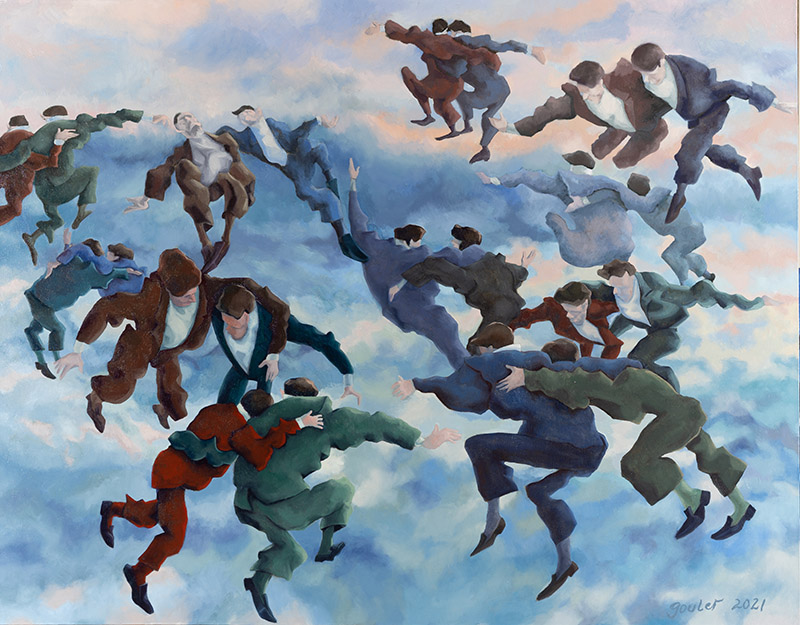In my first blog article, I thought I would attempt to answer a question I am often asked when I say that I am a painter: what do you paint? I paint figuratively, which means that when you look at my paintings, you know what you see. You feel that the picture tells a story, and you are right. I tell stories in paint.
What’s the story of “Bail Out”?
You will notice on my website that under every piece, there is a title. If I tell you that the title is part of the painting, then you might ask: what are all those businessmen doing, floating in the sky, and what does that have to do with a “bail out”? In my work, there is always a puzzle to solve. You don’t get the whole idea, all at once. Bear with me, I will tell you the story at the end of this article.
Where do the stories come from?
Each painting tells a different story. On my website, my work is displayed under six themes, but those are not tight categories. All paintings have one thing in common: they reflect special moments in my personal experience.
These are moments I call “epiphanies”. They are like sparks, rare and precious, when what I see before my eyes brings back memories or stirs intense feelings about our lives in the present. In those moments, I am overwhelmed by a powerful emotion: admiration, outrage, compassion, hope, despair, or a strong sense of ridicule. Immediately, images start flowing in my mind and they won’t let go until I find a solution. The solution is the painting.
How do I deal with my ideas?
I always start with some drawings, many drawings. When I draw the human figure, I exaggerate the proportions. I don’t seek to depict perfect anatomy. I seek what I need to convey the message. Although there are fundamental differences between their work and mine, expressionist painters had the same philosophy. They did not seek to be faithful to the reality they saw. They sought to “express” how they felt about it.
My ideas guide my imagination. I don’t use models, props nor photographs. I seldom paint on location. You will find that in my work, perspective is often problematic. The space is curved, the energy flows from the center, and the light source is the only anchor.
“Bail Out”
This is a story I had to learn: life is a lot better when you have someone on your side. As a civil servant, I was often overwhelmed by the intricacies of bureaucratic life. Back then, most people in positions of authority were men. There were many other challenges. Finding a way to work with a capricious boss, making sure not to hurt anybody’s feelings while working as a team, knowing how to handle competition and mediate between rivals. It did not come to me naturally.
What’s more: so many things could go wrong, as they still do. You could be harassed and there was no redress. You could be turned down for a promotion you well deserved, or fail the test and miss a chance for advancement. You could inadvertently forget to put away a CONFIDENTIAL document. You could fail to grasp your place in the hierarchy and have nightmares about your performance. At such times, it felt good to have a friend who would listen and hold your hand. Under the nebulous sky of deep uncertainties, when you feared you were losing your bearings, it was very difficult to navigate alone. With help, it was much easier to overcome the crisis and to move on.
